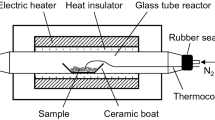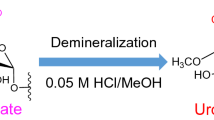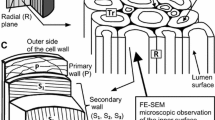Abstract
Aspen wood substrates with varying degrees of deacetylation, xylan, and lignin removal have been prepared and submitted to enzymatic hydrolysis with a cellulase/hemicellulase preparation for an extended constant period of hydrolysis. Controlled deacetylation has been achieved by treating wood with various alkali metal hydroxide solutions, at various alkali/wood ratios. It has been found that samples with the same extent of deacetylation produce the same sugar yields upon enzymatic hydrolysis. Increased degree of deacetylation increases the yield of sugars obtained from enzymatic hydrolysis, all other compositional parameters held constant. The acetyl group removal is proportional to the stoichiometric relation between added base and wood acetyl content, i.e., the same number of milliequivalents of base/weight of wood remove the same extent of acetyl groups, regardless of the concentration of the base solution. No cation effects are found among Li, Na, and K alkali hydroxide solutions, suggesting that swelling is not as important a parameter as is the removal of the acetyl groups from the xylan backbone in determining the extent of hydrolyzability of the resulting sample.
Similar content being viewed by others
References
Soltes, E. J. (1983),Biomass Utilization, Cote, W. A., ed., Plenum, New York, pp. 271–298.
Sjostrom, E. (1985),Wood Chemistry: Fundamentals and Applications, Academic Press, NY.
Browning, B. L. (1963),The Chemistry of Wood, Interscience Publishers, New York.
Goldstein, I. S. (1983),Wood and Agricultural Residues: Research on Use for Feed, Fuel, and Chemicals, Soltes, E. J., ed., Academic, New York, pp. 315–328.
Kennedy, J. F. and Paterson, M. (1989),Cellulose Utilization, Innagaki, H. and Phillips, G. O., eds., Elsevier Applied Science, London, pp. 203–212.
Gharpuray, M. M., Fan, L. T., and Lee, Y. H. (1983),Wood and Agricultural Residues: Research on Use for Feed, Fuel, and Chemicals, Soltes, E. J., ed., Academic, New York, pp. 369–389.
Jeffries, T. W. (1987),Wood and Cellulosics, Kennedy, J. F., Phillips, G. O., and Williams, P. A., eds., Ellis Horwood, Chichester, pp. 213–242.
Schwald, W., Brownell, H. H., and Saddler, J. N. (1988),Wood Chem. Technol. 8, 543.
Grohmann, K., Torget, R. and Hemmel, M. (1985),Biotechnol. Bioeng. Symp. 15, 59–80.
Gould, J. M. (1984),Biotechnol. Bioeng. 26, 46.
Gould, J. M. (1984),Biotechnol. Bioeng. 27, 225–231.
Kerley, M. S., Fahey, G. C., Berger, L. L., Gould, J. M., and Baker, F. L. (1985),Science 230, 820.
Helmling, O., Arnold, G., Rzehak, H., Fahey, G. C., Berger, L. L., and Merchen, N. R. (1989),Biotechnol. Bioeng. 33, 237.
Fan, L. T., Lee, Y. H., and Gharpuray, M. M. (1982),Adv. Biochem. Eng. 23, 157.
Grohmann, K., Mitchell, D. J., Himmel, M. E., Dale, B. E., and Schroeder, H. A. (1989),Appl. Biochem. Biotech. 20, 45–61.
Timell, T. E. (1967),Wood Science Technol. 1, 45.
Sinner, M., Parameswaran, H., and Dietrichs, H. H. (1979),Adv. Chem. Ser. 181, 303–329.
Browning, B. L. (1967),Methods of Wood Chemistry, Interscience, New York.
Soltes, E. J. (1989),Mechanisms of Plant Cell Wall Resistance to Attack by Polysaccharide Degrading Enzymes, Final Report, SERI subcontract XK-7-07031-9.
Kong, F. (1990),Effect of Acetate and Other Cell Wall Components on Enzymatic Hydrolysis of Aspen Wood. M.S. Thesis, Forest Science, Texas A&M University, College Station, TX.
Baker, A. J., Millet, M. A., and Setter, L. D. (1975),Cellulose Technology Research, A. F. Turbak, ed. (American Chemical Society, Washignton, D.C.), pp. 75–105.
Rydholm, S. A. (1965),Pulping Processes, Interscience, New York, p. 95.
Soltes, E. J. (1980),Wood Chemistry Laboratory Manual, Department of Forest Science, Texas A&M University, College Station, TX.
Miller, G. L. (1959),Anal. Chem. 31, 427.
Chang, L., Chang, T., and Li, L. (1988),Methods of Biochemistry, Higher Education, Beijing, p. 9.
Yu, Q. (1985),Methods of Plant Physiology and Biochemistry, Higher Education, Beijing, p. 6.
Stamm, A. J. (1964),Wood and Cellulose Science, Ronald Press, New York, pp. 249–250.
Weast, R. C., Astle, M. J., and Beyer, W. H. (1985), eds.,CRC Handbook of Chemistry and Physics, CRC Press, Boca Raton, FL, p. F-164.
Rowell, R. M. (1984),The Chemistry of Solid Wood, Rowell, R. M., ed., American Chemical Society, Washington D.C., pp. 175–210.
Author information
Authors and Affiliations
Rights and permissions
About this article
Cite this article
Kong, F., Engler, C.R. & Soltes, E.J. Effects of cell-wall acetate, xylan backbone, and lignin on enzymatic hydrolysis of aspen wood. Appl Biochem Biotechnol 34, 23–35 (1992). https://doi.org/10.1007/BF02920531
Issue Date:
DOI: https://doi.org/10.1007/BF02920531




